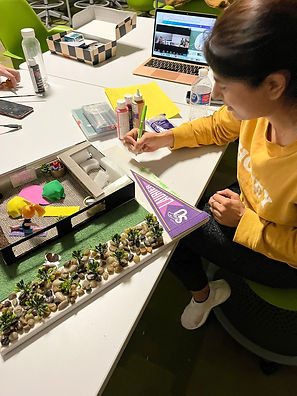Project Overview
Project Information
My Role
Product Designer
Project Type
Group Project
Duration
2 Months
Overview
Iterative Phases of Critical Making: Inspiration, Understanding, Ideation, Making, Sharing
My team was assigned two term projects titled Somatic Design Project One and Two. The first project aimed to create a stress-free environment for neurodivergent students by incorporating five sensory experiences: sight, sound, touch, motion, and smell. The team built a diorama depicting an ideal calming setting, including soundproofing, sensory-friendly lighting, and comfortable seating.
The second project focused on developing an immersive gaming experience to combat social isolation in online gaming. The team created an AI Play Pal using IoT technology to provide a tactile and engaging gaming experience that connects players with one another, addressing the solitude often experienced in online gaming.
Team
Hania Khawar, Aliyah Ishmail, Mya Certossi, Sanaa Khalil

The diorama
Design Challenge
Our team developed and built a multi-sensory space for neurodivergent students that addresses their sensory needs, particularly those with neurodiverse disorders like autism, ADHD, and sensory processing disorder. This space provide a range of sensory experiences through sight, sound, touch, motion, and smell, creating a safe, calming, and supportive environment that helps these students feel comfortable, focused and engaged. The design of the sensory space includes elements such as soft lighting, comfortable seating, and various sensory toys or activities. In addition, we ensured that the space is physically accessible to students with mobility needs and that the sensory experiences are accessible to those with vision or hearing impairments.



Prototype
The illustrations represent each distinct concept that our group intended to include in a diorama.
Low Fidelity

Medium Fidelity

Building Prototype

Supplies & Material
Arduino Board

Adding Arduino

Final Design
Top View

Side View

Front View


Play pal
Design Challenge
Our team has developed an AI Play Pal using clay, a gaming device that aims to reduce social isolation in gaming. The AI Play Pal goal's is to provide an inclusive and engaging gaming experience for its users.The device incorporates IoT LED by using lights, a speaker, and a range of textures to provide an immersive and tactile experience to its users. The project also involved the creation of low-fidelity prototypes using pencil and clay.



Prototype
Low Fidelity Prototype


Building Prototype



Final Design
Front View

Top View

Side View

Bottom View

My Involvement in the Maker Projects
My participation in the maker projects enabled me to complete two projects that emphasize somatic design. Through our original designs and concepts, the diorama and the Play Pal both represent the somatic sensory experiences.
Both projects focus on somatic experiences users can interact with. The design of the A multi-sensory space for neurodivergent students that addresses their sensory needs, particularly those with neurodiverse disorders like autism, ADHD, and sensory processing disorder. The diorama offers students a low-stimulation atmosphere to ease social anxiety and other mental health issues. Our Play Pal device, in the shape of an umbrella octopus, provides companionship and tailored feedback to different types of gamers. It uses tracking software to analyze gameplay and AI to fuel conversations. Overall, these two projects allowed me the chance to practice multi-sensory somatic design.

Learning Through the Design Process
I had the chance to learn how to create somatic experiences using Arduino while designing the projects. Our design team concentrated on comprehending our users' requirements throughout the process.
Evolution as a UX Designer
I've become a more capable UX designer as a result of the design processes for both of these projects. The five iterative stages of the critical creating process were stimulated for me by the group maker projects. Our group started each phase by conducting primary and secondary research to identify our issue, which enabled us to start each process and start the stages of inspiration and understanding. During the ideation stage, we changed our focus from an issue and an item to a solution that attempts to meet the demands of our users. Making was an important step in our approach because it forced us to consider our idea in three dimensions. We then presented our solution to the class to assist the sharing stage.
Group Challenges
Our team encountered a few small technical difficulties when creating our prototype. Our group would have benefited from conducting research in advance of meetings because we had a limited amount of time to prepare our design as a team in person. This would have allowed us to guarantee that our diorama had somatic experience.
While making our prototype of the diorama, our team struggled to stick the pebbles on the canvas with normal so we had to use hot glue instead. Another challenge we faced was that our miniature doll was too big with the proportion of the diorama, so we had to borrow dolls a child.
While creating the Play Pal prototype our group faced a few challenges. The clay's malleability was the main issue, it made it difficult to handle and shape. Another challenge we faced was preserving the proper scale and proportion of the design while making a clay prototype. The Arduino did not fit in the prototype as well as we had anticipated. Finally, We had to use a paintbrush and water to rub over the fractures in the clay to smooth it out. The clay prototype started to break when it dried so we had to seal the cracks with glue.
Aspects of the Design Challenge
Aspects that worked well
The designing aspects of the design process were quite beneficial to both maker projects. Our team had all the tools it needed to make the prototype, so we could be sure it would work. Using materials and craft supplies we already owned, we made our diorama and Play Pal. These two types of materials also contained our tools and paper. The most often utilized materials for our diorama and Play Pal prototypes were glue guns, liquid glue, scissors, and tape. We chose construction paper and cardboard boxes as our paper goods.
Aspects that didn't work well
The sharing components of the design process didn't work very well. More comments, recommendations, or feedback from the audience would have been beneficial to our group. Although the audience gave both projects positive reviews, there weren't many comments to help us with our subsequent adjustments. To improve audience engagement, our team need to have utilised volunteers and entertaining activities for the audience members to partake in. By doing this, we could maintain the interest of our students and gain better feedback.
Concluding Evaluation for the Final Design
The final maker projects, despite some small hurdles and difficulties, effectively achieved our planned aims and ambitions. The Somatic Design Project One and Two were created with somatic experiences in mind. Our team has decided to present the diorama to the Laurier Hub as a project proposal after hearing positive feedback from the audience.


